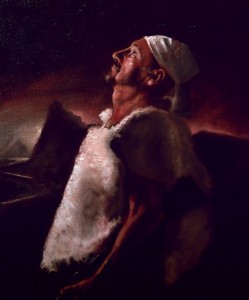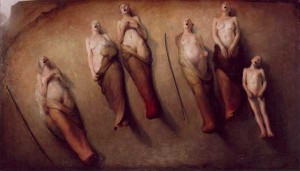A few words about Odd Nerdrum and Kitsch
Robert Dale Williams interviewed by Signy Norendal
For the Norwegian magazine Aktuell Kitsch, September 5, 2007
When, why and how did you start painting?
My ambitions were centered on illustration when I was younger. I always loved to tell stories with my drawings. My favorites were the very romantic or morally driven stories – the more sentimental the better. I once illustrated The Phantom of the Opera because I loved the dark romantic element to the story. My adaptation was never published on a large scale – I just loved illustrating the stories so much that I did it without thought of financial gain.
Although I’d never say I completely “mastered” illustration, I wanted a greater challenge when I began my formal studies in 1996. My favorite painters were Rembrandt, Michelangelo, and Van Gogh. A formal education in art today means that you, as a student, are likely to be driven away from all that you loved about what you thought was “art” when you arrived at the University. My instructors appreciated my enthusiasm for the Old Masters, but it wasn’t long before I was being encouraged to experiment with my form and content. I wanted to make bold, dramatic paintings like the Old Masters – and I discovered Odd Nerdrum as an undergraduate student, so I knew it could be done with contemporary equipment. My professors, however, insisted that no one should, or could, paint as the masters did. A “that was then, this is now” attitude is prevalent among educators because they are an extension of the art world itself. Predictably, my attempts at bold, ambitious compositions as an undergraduate student were terrible failures. I didn’t learn the proper techniques until I attended the New York Academy of Art Graduate School of Figurative Art.
Why and how did you become a student of Odd Nerdrum? When did you study with Nerdrum?
To my surprise, Odd Nerdrum was a controversial figure at the New York Academy of Art. I was still very naïve – the Academy is very much an “art” school despite its instruction in classical techniques. I met some former students of the Academy who had studied with Odd Nerdrum at his summer residence, and I thought it was extraordinary that a painter of his stature would invite aspiring painters to study under him. I know of no other painter of his caliber who offers such opportunities.
In the fall of 2003, I was still struggling to improve my painting skill at the Academy, but I found the confidence to send some samples of my best work to Odd Nerdrum’s American representatives at the Forum Gallery in hopes of studying with him. A few months later, to my surprise and delight, I was invited to study with him the following summer of 2004.
I worked as a studio assistant for Odd Nerdrum in the summers of 2004, 2005, and 2007.
Are the concepts ”kitsch” and ”art” interesting or important questions for you – and in that case – how and why? Do you see yourself as an artist or a kitsch-painter?
For years, I didn’t understand it, especially as an undergraduate student. My art instructors criticized me for years because they identified this terrible “fault” of mine as an artist – my tendency to create kitsch. Everything is acceptable in art except for sentimental pictures, and everything I wanted in my work had a sentimental quality. Everything I appreciate and strive for is “old” to the art world, and that works completely opposite of that which is considered “quality” in art.
When I read “On Kitsch”, I knew that Odd Nerdrum and Jan Ove Tuv had identified the core issue facing contemporary painters. I finally understood that I wasn’t an artist at all. What’s funny to me is for all of the fear that artists have of being labeled “kitsch”, I felt absolutely liberated once I embraced the fact that what I create is not “art”.
I’m learning more about the revisionist history that art historians have manufactured – the fact that the Old Masters didn’t think of themselves as “artists”, but craftsmen. The artificial line that has been fabricated to link modernism to the Masters is disgusting to me, not to mention insulting. Likening the tossing of paint, as Jackson Pollack did, to the meticulous, skilled hand of Rembrandt is silliness to me.
Artists have no power in the art world – critics, curators, and historians do. The primary function of art critic is to strengthen and maintain the fabricated link between modernism and the masterly craftsmen of centuries past. The stronger the link, the more legitimate those color field and abstract expressionist paintings seem. They wouldn’t dream of acknowledging that it is something different altogether. Art critics do a great disservice to the practice of painting when they can say, “Pollack equals or betters Rembrandt,” and the population nods and agrees. They wield amazing power – they can dictate what is worthwhile. They dictate what has quality, not the artist.
Art lovers love to talk about the “thought provoking” nature of art – a Warhol “makes them think”, where they do not have to think when they look at a Rembrandt. That is contrived silliness to me. If I want to “think”, I’ll do a math problem. When I look at a Warhol, I think, “There is a depressed individual who hates himself and mankind.” The mind games and cynicism in modern art just depresses me.
How will you describe your period with Nerdrum? What impact do you think Nerdrum has had on you as a painter?
I grew as a painter in so many ways. I found the confidence to embrace the sentimental themes I’ve wanted to paint, but was discouraged from painting by art educators. I’ve become extremely critical – that is so important if you want to become a strong painter. I’m critical of myself and everything I see. I’m always comparing. You learn to look for more, and to look for the best, when you study with Odd Nerdrum.
I think there are a lot of misconceptions about what it is to study with Odd Nerdrum. He doesn’t teach you “his technique” – his technique is changing all the time. He is always experimenting. What is more important, I think, is how you begin to think about your own paintings as you watch him create his. I have to say it was important to learn that he is a kind, friendly person who loves life and loves his family – when you study with him, you realize that he is painting his life.
I can’t underestimate how valuable it has been to meet like-minded painters. The relationships between the other kitsch painters are special, I think. It is competitive, to be sure, but in the best way. We are genuinely happy to see each other’s successes.
Please, tell me about your “Wrath of the tyrant”. What’s the story – the message? It’s a masterful composition. The subject, however, might be harder to grasp.
With “Wrath of the Tyrant”, my goal was to make a large painting of a tragic scene that could take place 500 years ago, today, or 500 years from now. I wanted to make a painting that recalled Michelanglo’s Last Judgment and Géricault’s Raft of the Medusa. As I painted the picture, many people asked me what the story was. Many people thought I was making a commentary about contemporary life. However, none of my paintings are addressing specific events, and they certainly are not intended to be a political commentary.
Some people are confused when I tell them that “Wrath of the Tyrant” is a sentimental picture. This is because they can’t get beyond the violence of the scene. The point of the picture is that we empathize with the group of people who are frightened. It is this empathy that makes the painting extremely sentimental.
Could you say something about what you want with your pictures? Do you have specific messages or emotions you wish to express? A set of values attached to your work?
My goal is to present the human condition and, if I am successful, evoke empathy from the viewer – this is a key element in kitsch paintings. Modern art critics insist that the work should evoke nothing so that the viewer can project their experience onto the work. Mark Rothko is a good example – the colors red and brown in and of themselves don’t move us; it is how we experience Rothko’s red over brown that is important. The kind of drama you find in great kitsch paintings is a sin in the art world – a sin to appreciate it, and a greater sin to paint it.
I do not project any morality onto my paintings. However, each figure in the composition is significant to me, because each one is another human soul. It strikes me just how lyrical, or even beautiful, a violent scene can be.
What would you say inspires you?
The Old Masters inspire me. Painting miracles inspire me. The idea of participating in the grand tradition of painting excites me, and it keeps me working.
What are your greatest challenges as a painter?
Building a body of quality work on a strict budget is difficult. Financial demands of everyday life are a challenge. Then, of course, there is the challenge of marketing yourself and your work in an industry that, by and large, sees what you create as outdated and perpetually “out of style”. It’s like being a great horse jockey in the auto racing world – what is the jockey doing there? He should go be with his own people – such is the feeling of the kitsch painter in the art world.
What is more important – form or content?
Content overrides everything, but if a painter has no form – no technical skill – the results will be poor. Or, you could say the result would be “art”, because in art, a painter can be naïve and untrained but still considered a “genius”. With kitsch, respect is earned only through strong technique in conjunction with thoughtful content. A painter can have tremendous technical skill, yet still unable to produce a memorable picture – that is where content comes in. A great kitsch painter treats his subject matter, and his unknown viewers, with the utmost respect. Kitsch painters respect humanity, where artists are more interested in mockery and humiliation.
Could you say a few words about your thoughts on your own classical way of painting, maybe vs. modernistic art?
Kitsch painters aren’t trying to say that “classical painting” is better than modern art; they are insisting that it is different and should stand alone from it. Artists and art critics have created something that is very fragile and whimsical – this thing we know as art. When I look at paintings by the Masters, I see strength, purpose, and dignity. When I compare Basquiat to Rembrandt, I see the results of human beings engaged in very different endeavors. The failing of modern art is the belief that because elements of society have changed, the eternal human experience has changed. This simply isn’t true. We still love and hurt each other as much as we ever have – the times shouldn’t make us hate a painter for portraying that fact in a moving picture.
Source:robertdalewilliams.com




This Post Has 2 Comments